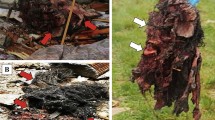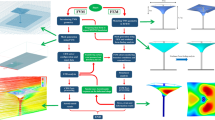Abstract
A mechanized and integrated computational scheme is introduced to determine the human brain responses in an environment where the human head is exposed to explosions from trinitrotoluene (TNT), or other high-yield explosives, in military applications. The procedure is based on a three-dimensional (3-D) non-linear finite element method (FEM) that implements a simultaneous conduction of explosive detonation, shock wave propagation, blast–head interactions, and the confronting human head. The processes of blast propagation in the air and blast interaction with the head are modeled by an Arbitrary Lagrangian–Eulerian (ALE) multi-material FEM formulation, together with a penalty-based fluid/structure interaction (FSI) algorithm. Such a model has already been successfully validated against experimental data regarding air-free blast and plate–blast interactions. The human head model is a 3-D geometrically realistic configuration that has been previously validated against the brain intracranial pressure (ICP), as well as shear and principal strains under different impact loadings of cadaveric experimental tests of Hardy et al. [Hardy W. N., C. Foster, M. Mason, S. Chirag, J. Bishop, M. Bey, W. Anderst, and S. Tashman. A study of the response of the human cadaver head to impact. Proc. 51 st Stapp. Car Crash J. 17–80, 2007]. Different scenarios have been assumed to capture an appropriate picture of the brain response at a constant stand-off distance of nearly 80 cm from the core of the explosion, but exposed to different amounts of a highly explosive (HE) material such as TNT. The overpressures at the vicinity of the head are in the range of about 2.4–8.7 atmosphere (atm), considering the reflected pressure from the head. The methodology provides brain ICP, maximum shear stresses and maximum principal strain within the milli-scale time frame of this highly dynamic phenomenon. While focusing on the two mechanical parameters of pressure, and also on the maximum shear stress and maximum principal strain to predict the brain injury, the research provides an assessment of the brain responses to different amounts of overpressure. The research also demonstrates the ability to predict the ICP, as well as the stress and strain within the brain, due to such an event. The research cannot identify, however, the specific levels of ICP, stress and strain that necessarily lead to traumatic brain injury (TBI) because there is no access to experimental data regarding head–blast interactions.











Similar content being viewed by others
References
Alia, A., and M. Souli. High explosive simulation using multi-material formulations. Appl. Thermal. Eng. 26:1032–1042, 2006.
Anderson, R. W. G., C. J. Brown, P. C. Blumbergs, G. Scott, J. W. Finney, N. R. Jones, and A. J. Mclean. Mechanisms of axonal injury: an experimental and numerical study of a sheep model of head impact. In: Proceedings of the International Conference on the Biomechanics of Impact, pp. 107–120, 1999.
Bain, A. C., and D. F. Meaney. Tissue-level thresholds for axonal damage in an experimental model of central nervous system white matter injury. J. Biomech. Eng. 16:615–622, 2000.
Benson, D. J. A mixture theory for contact in multi-material Eulerian formulations. Comput. Methods Appl. Mech. Eng. 140:59–86, 1997.
Bradshaw, D. R. S., and C. L. Morfey. Pressure and shear response in brain injury models. In: Proceedings of the 17th International Technical Conference on the Enhanced Safety of Vehicles, Amsterdam, The Netherlands, 2001.
Chafi, M. S., V. Dirisala, G. Karami, and M. Ziejewski. A finite element method parametric study of the dynamic response of the human brain with different cerebrospinal fluid constitutive properties. Proc. IMechE Vol. 223 Part H: J. Eng. Med. doi:10.1243/09544119JEIM631.
Chafi, M. S., V. Dirisala, G. Karami, and M. Ziejewski. Biomechanical examination of brain-skull relative motion and brain strain, and intracranial pressure under kinematical impact loading. Comput. Math. Methods Med. (under review), 2009.
Chafi, M. S., G. Karami, and M. Ziejewski. Numerical analysis of blast-induced wave propagation using FSI and ALE multi-material formulations. Int. J. Impact Eng. doi:10.1016/j.ijimpeng.2009.03.007.
Denny-Brown, D., and W. R. Russell. Experimental cerebral concussion. Brain 64:93–164, 1941.
Dobratz, B. M. LLNL Explosives Handbook, Properties of Chemical Explosives and Explosive Stimulants. Lawrence Livermore National Laboratory, Univ. of Calif. Rept. UCRL-52997, 1981.
Elsayed, N. M. Toxicology of blast overpressure. Toxicology 121:1–15, 1997.
Gefen, A., and S. S. Margulies. Are in vivo and in situ brain tissues mechanically similar? J. Biomech. 37:1339–1352, 2004.
Gilchrist, M. D. Modeling and accident reconstruction of head impact injuries. Key Eng. Mater. 245–246:417–429, 2003.
Gurdjian, E., and E. S. Gurdjian. Acute head injuries. Surgery 146:805–820, 1978.
Hardy, W. N., C. Foster, M. Mason, S. Chirag, J. Bishop, M. Bey, W. Anderst, and S. Tashman. A study of the response of the human cadaver head to impact. Proc. 51st Stapp. Car Crash J. 17–80, 2007.
Horgan, T. J., and M. D. Gilchirst. The creation of three-dimensional finite element models for simulating head impact biomechanics. Int. J. Crashworthiness 8:1–14, 2003.
Kang, H. S., R. Willimger, B. M. Diaw, and B. Chinn. Modeling of the human head under impact conditions: a parametric study. In: Proceedings of the 41st Stapp Car Crash Conference, SAE Paper No. 973338, 1997.
Kleiven, S., and W. N. Hardy. Correlation of an FE model of the human head with local brain motion—consequences for injury prediction. In: Proceedings of the 46th Stapp Car Crash Conference, pp. 123–143, 2002.
Kleiven, S., and H. Von Holst. Consequences of head size following trauma to the human head. J. Biomech. 35:153–160, 2002.
Ls-dyna keyword user manual. Version 971, Livermore Software Technology Corporation, 2006.
Mayorga, M. A. The pathology of primary blast overpressure injury. Toxicology 121:17–28, 1997.
Mclean, A. J. Brain injury without head impact? J. Neurotrauma 12:621–625, 1995.
Mendis, K. K., R. K. Stalnaker, and S. H. Advani. A constitutive relationship for large deformation finite element modeling of brain tissue. J. Biomech. Eng. Trans. ASME 117:279–285, 1995.
Miller, R. T., S. S. Margulies, M. Leoni, M. Nonaka, X. Chen, D. H. Smith, and D. F. Meaney. Finite element modeling approaches for predicting injury in an experimental model of severe diffuse axonal injury. In: Proceedings of the 42nd Stapp Car Crash Conference, pp. 155–166, 1998.
Morrision, III, B., H. L. Cater, C. C.-B. Wang, F. C. Thomas, C. T. Hung, G. A. Ateshian, and L. E. Sundstrom. A tissue level tolerance criterion for living brain developed with an in vitro model of traumatic mechanical loading. Stapp Car Crash J. 47:93–105, 2003.
Nahum, A. M., R. Smith, and C. C. Ward. Intracranial pressure dynamics during head impact. In: Proceedings of the 21st Stapp Car Crash Conference, pp. 337–366, 1977.
O’Donoghue, D., and M. D. Gilchrist. Strategies for modeling brain impact injuries. Irish J. Med. Sci. 167:263–264, 1998.
Ommaya, A. K. The mechanical properties of tissues of the nervous system. J. Biomech. 2:1–12, 1968.
Ommaya, A. K. Head injury mechanisms and the concept of preventive management: a review and critical synthesis. J. Neurotrauma 12:527–546, 1995.
Prange, M. T., and S. S. Margulies. Regional, directional, and age-dependent properties of the brain undergoing large deformation. J. Biomech. Eng. 124:244–252, 2002.
Ruan, J. S., T. B. Khalil, and A. I. King. Human head dynamic response to side impact by finite element modeling. ASME J. Biomech. Eng. 113:276–283, 1991.
Sano, K., N. Nakamura, and K. Hirakawa. Mechanism of and dynamics of closed head injuries. Neurol. Mediochir. 9:21–23, 1967.
Shreiber, D. I., A. C. Bain, and D. F. Meaney. In vivo thresholds for mechanical injury to the blood–brain barrier. In: Proceedings of the 41st Stapp Car Crash Conference, pp. 277–291, 1997.
Shuck, L., and S. Advani. Rheological response of human brain tissue in shear. J. Basic Eng. 94:905–911, 1972.
Souli, M., A. Ouahsine, and L. Lewin. ALE formulation for fluid–structure interaction problems. Comput. Meth. Appl. Mech. Eng. 190:659–675, 2000.
Taber, K. H., D. L. Warden, and R. A. Hurley. Blast-related traumatic brain injury: what is known? J. Neuropsychiatry Clin. Neurosci. 18:141–145, 2006.
Takhounts, E. G., J. R. Crandall, and K. K. Darvish. On the importance of nonlinearity of brain tissue under large deformations. Stapp Car Crash J. 47:107–134, 2003.
Ward, C. C., M. Chan, and A. M. Nahum. Intracranial pressure—a brain injury criterion. In: Proceedings, 24th Stapp Car Crash Conference, SAE Paper No. 801304, 1980.
Willinger, R., H. Kang, and B. Diaw. Three-dimensional human head finite-element model validation against two experimental impacts. Ann. Biomed. Eng. 27:403–410, 1999.
Willinger, R., L. Taleb, and C. M. Kopp. Modal and temporal analysis of head mathematical models. J. Neurotrauma 12:743–754, 1995.
Willinger, R., L. Taled, and P. Pradore. Head biomechanics: from the finite element model to the physical model. In: Proceedings of the IRCOBI Conference. Brunnen, Switzerland, International Research Council on the Biomechanics of Impact, Bron, France, pp. 245–260, 1995.
Zhou, C., T. B. Khalil, and A. I. King. A new model comparing impact responses of the homogeneous and inhomogeneous human brain. In: Proceedings of the 39th Stapp Car Crash Conference, pp. 121–137, 1995.
Acknowledgments
The authors would like to acknowledge the Air Force Office of Scientific Research (AFOSR) for the financial support of this work.
Author information
Authors and Affiliations
Corresponding author
Rights and permissions
About this article
Cite this article
Chafi, M.S., Karami, G. & Ziejewski, M. Biomechanical Assessment of Brain Dynamic Responses Due to Blast Pressure Waves. Ann Biomed Eng 38, 490–504 (2010). https://doi.org/10.1007/s10439-009-9813-z
Received:
Accepted:
Published:
Issue Date:
DOI: https://doi.org/10.1007/s10439-009-9813-z




